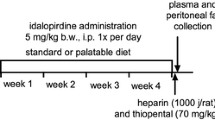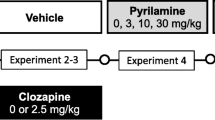Abstract
The effects of eight serotonin (5-HT) receptor antagonists on the anorectic effect of d-fenfluramine (3.0 mg/kg, IP) were examined in a test of sweet mash consumption, using non-deprived male rats. d-Fenfluramine's effect was attenuated by the mixed 5-HT1/5-HT2 receptor antagonists, methiothepin and metergoline; by the 5-HT2 receptor antagonist ritanserin; and by (±)cyanopindolol, a mixed 5-HT1A/5-HT1B receptor antagonist. In contrast, d-fenfluramine's effect was not antagonised by the 5-HT2 receptor antagonists ketanserin and ICI 169 369; the 5-HT3 receptor antagonist ICS 205 930; or by xylamidine, a peripheral 5-HT receptor antagonist. In this feeding model, none of the 5-HT antagonists, when tested alone, had any effect to increase palatable food consumption. The pattern of results obtained strongly suggest that central 5-HT1 receptors play an important role in the mediation of d-fenfluramine-induced anorexia.
Similar content being viewed by others
References
Baker BJ, Duggan JP, Barber DJ, Booth DA (1988) Effects of dl-fenfluramine and xylamidine on gastric emptying of maintenance diet in freely feeding rats. Eur J Pharmacol 150: 137–142
Barrett AM, McSharry L (1975) Inhibition of drug-induced anorexia in rats by methysergide. J Pharma Pharmacol 27: 889–895
Blackburn TP, Thornber CW, Pearce RJ, Cox B (1987) In vivo pharmacology of ICI 169 369 — a new 5-HT2 antagonist. Br J Pharmacol 90: 277P
Blundell JE (1984) Serotonin and appetite. Neuropharmacology 23: 1537–1551
Blundell JE, Latham CJ (1980) Characterisation of adjustments to the structure of feeding behavior following pharmacological treatment: effects of amphetamine and fenfluramine and the antagonism produced by pimozide and metergoline. Pharmacol Biochem Behav 12: 717–722
Borsini F, Bendotti C, Aleotti A, Samanin R, Garattini S (1982) d-Fenfluramine and d-norfenfluramine reduce food intake by acting on different serotonin mechanisms in the rat brain. Pharmacol Res Commun 14: 671–678
Borsini F, Bendotti C, Samanin R (1985) Salbutamol, d-amphetamine and d-fenfluramine reduce sucrose intake in freely fed rats by acting on different neurochemical mechanisms. Int J Obes 9: 277–283
Bradley PB, Engel G, Feniuk W, Fozard JR, Humphrey PPA, Middlemiss DN, Mylecharane EJ, Richardson BP, Saxena PR (1986) Proposals for the classification and nomenclature of functional receptors for 5-hydroxytryptamine. Neuropharmacology 25: 563–576
Carruba MO, Mantegazza P, Memo M, Missale C, Spano PF (1986) Peripheral and central mechanisms of action of serotonergic anorectic drugs. Appetite [Suppl] 7: 105–113
Clineschmidt BV, McGuffin JC, Werner AB (1974) Role of monoamines in the anorexigenic actions of fenfluramine, amphetamine and p-chloroamphetamine. Eur J Pharmacol 27: 313–323
Cooper SJ (1986) Hyperphagic and anorectic effects of β-carbolines in a palatable food consumption test: comparisons with triazolam and quazepam. Eur J Pharmacol 120: 257–265
Copp FC, Green AF, Hodson HF, Randall AW, Sim MF (1967) New peripheral antagonists of 5-hydroxytryptamine. Nature 214: 200–201
Dourish CT, Cooper SJ, Gilbert F, Coughlan J, Iversen SD (1988a) The 5-HT1A agonist 8-OH-DPAT increases consumption of palatable wet mash and liquid diets in the rat. Psychopharmacology 94: 58–63
Dourish CT, Clark ML, Fletcher A, Iversen SD (1988b) Evidence that blockade of postsynaptic 5-HT1 receptors elicits feeding in satiated rats. Psychopharmacology (in press)
Engel G, Gothert M, Hoyer D, Schlicker E, Hillenbrand K (1986) Identity of inhibitory presynaptic 5-hydroxytryptamine (5-HT) autoreceptors in the rat brain cortex with 5-HT1B binding sites. Naunyn-Schmiedeberg's Arch Pharmacol 332: 1–7
Fletcher PJ (1987) Serotonin antagonists and feeding. Soc Neurosci Abstr 13: 1173
Fletcher PJ, Burton MJ (1986) Dissociation of the anorectic actions of 5-HTP and fenfluramine. Psychopharmacology 89: 216–220
Fuller RW, Kurz KD, Mason NR, Cohen MC (1986) Antagonism of a peripheral vascular but not an apparently central serotonergic response by xylamidine and BW 501C67. Eur J Pharmacol 125: 71–77
Garattini S, Mennini T, Bendotti C, Invernizzi R, Samanin R (1986a) Neurochemical mechanism of action of drugs which modify feeding via the serotonergic system. Appetite [Suppl] 7: 15–38
Garattini S, Mennini T, Samanin R (1986b) From fenfluramine racemate to d-fenfluramine; specificity and potency of the effects on the serotoninergic system and food intake. Ann NY Acad Sci 499: 156–166
Heuring RE, Peroutka SJ (1987) Characterization of a novel 3H-5-hydroxytryptamine binding site subtype in bovine brain membranes. J Neurosci 7: 894–903
Hewson G, Leighton GE, Hill RG, Hughes J (1988) Ketanserin antagonises the anorectic effect of dl-fenfluramine in the rat. Eur J Pharmacol 145:227–230
Hoyer D (1988) Functional correlates of serotonin 5-HT1 recognition sites. J Recept Res (in press)
Hoyer D, Engel G, Kalkman HO (1985) Molecular pharmacology of 5-HT1 and 5-HT2 recognition sites in rat and pig brain membranes: radioligand binding studies with [3H]5-HT, [3H]8-OH-DPAT, (−)[125I]cyanopindolol, [3H]mesulergine and [3H]ketanserin. Eur J Pharmacol 118: 13–23
Invernizzi R, Berettera C, Garattini S, Samanin R (1986) d- and l-isomers of fenfluramine differ markedly in their interaction with brain serotonin and catecholamines in the rat. Eur J Pharmacol 120: 9–15
Jespersen J, Scheel-Krüger J (1973) Evidence for a difference in mechanism of action between fenfluramine- and amphetamine-induced anorexia. J Pharm Pharmacol 25: 49–54
Leysen JE, Awouters F, Kennis L, Laduron PM, Vandenberk J, Janssen PAJ (1981) Receptor binding profile of R41 468, a novel antagonist at 5-HT2 receptors. Life Sci 28: 1015–1022
Leysen JE, Gommeren W, Van Gompel P, Wynans J, Janssen PAJ, Laduron PM (1985) Receptor-binding properties in vitro and in vivo of ritanserin: a very potent and long acting serotonin-S2 antagonist. Mol Pharmacol 27: 600–611
Massi M, Marini S (1987) Effect of the 5-HT2 antagonist ritanserin on food intake and on 5-HT-induced anorexia in the rat. Pharmacol Biochem Behav 26: 333–340
Mawson C, Whittington H (1970) Evaluation of the peripheral and central antagonistic activities against 5-hydroxytryptamine of some new agents. Br J Pharmacol 39: 223P
Middlemiss DN, Hibert M, Fozard JR (1986) Drugs acting at central 5-hydroxytryptamine receptors. Annu Rep Med Chem 21: 41–50
Neill JC, Cooper SJ (1988) Evidence for serotonergic modulation of sucrose sham-feeding in the gastric-fistulated rat. Physiol Behav (in press)
Pazos A, Hoyer D, Palacios JM (1985) The binding of serotonergic ligands to the porcine choroid plexus: characterisation of a new type of serotonin recognition site. Eur J Pharmacol 106: 539–546
Pedigo NW, Yamamura HI, Nelson DC (1981) Discrimination of multiple 3H 5-hydroxytryptamine binding sites by the neuroleptic spiperone in rat brain. J Neurochem 36: 220–226
Pollock JD, Rowland N (1981) Peripherally administered serotonin decreases food intake in rats. Pharmacol Biochem Behav 15: 179–183
Simansky KJ, Cohen BI, Eberle K (1987) Inhibition by 5-HT2 antagonists of the anorexic actions of peripherally administered 5-hydroxytryptamine (5-HT) and 4-HT in rats. Soc Neurosci Abstr 13: 15
Richardson BP, Engel G, Donatsch P, Stadler PA (1985) Identification of serotonin M-receptor subtypes and their specific blockade by a new class of drugs. Nature 316: 126–131
Rowland NE, Carlton J (1986) Neurobiology of an anorectic drug: fenfluramine. Prog Neurobiol 27: 13–62
Winer BJ (1971) Statistical principles in experimental design, 2nd edn. McGraw-Hill, New York
Author information
Authors and Affiliations
Rights and permissions
About this article
Cite this article
Neill, J.C., Cooper, S.J. Evidence that d-fenfluramine anorexia is mediated by 5-HT1 receptors. Psychopharmacology 97, 213–218 (1989). https://doi.org/10.1007/BF00442252
Received:
Accepted:
Issue Date:
DOI: https://doi.org/10.1007/BF00442252




